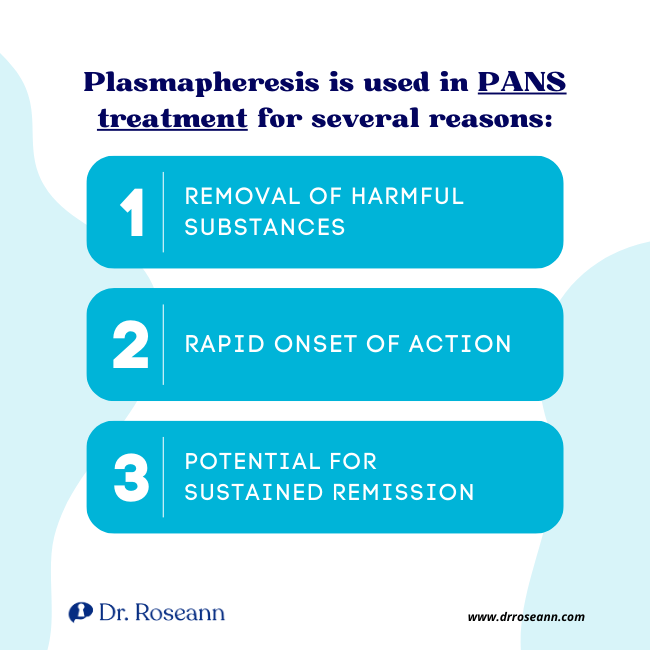If you have a child with PANS (Pediatric Acute-onset Neuropsychiatric Syndrome), then you can call yourself a warrior facing this battle affecting your whole family. But amidst the challenges, there are treatments that can help.
Plasmapheresis treatment is used when tick-borne illness is part of the PANS puzzle.
What is Plasmapheresis?
Plasmapheresis, often called plasma exchange or plex therapy, is a therapeutic procedure to remove harmful antibodies or toxins from the bloodstream. As it separates the plasma from the other blood components, problematic substances are effectively eliminated, allowing the body to reset and heal.

Plasmapheresis acts as a purification system, filtering out toxins and restoring the flow of life-giving elements. This gentle yet powerful process offers renewed hope for families struggling with the complexities of PANS.
The Role of Plasmapheresis in PANS Treatment
Plasmapheresis offers a targeted approach to addressing the immune dysfunction believed to underlie PANS. During plasmapheresis, blood is withdrawn from the patient, and the plasma, which contains potentially harmful antibodies and toxins, is separated from the cellular components.
The plasma is then replaced with a solution or donor plasma before reintroducing into the patient's circulation. Over my many years of working with patients with Lyme and tick-borne illness, I have seen this treatment used. I witnessed it be especially helpful for those when antibiotic treatment was ineffective.
Plasmapheresis is used in PANS treatment for several reasons:

Removal of Harmful Substances
Plasmapheresis aims to reset the immune system and alleviate neuropsychiatric symptoms by eliminating circulating antibodies and toxins implicated in the pathogenesis of PANS. It can also be helpful when used alongside chemotherapy for treating cancers such as multiple myeloma (Madore, 2002).
Rapid Onset of Action
Unlike some traditional treatments that may take weeks or months to exert their therapeutic effects, plasmapheresis can lead to rapid improvement in symptoms, offering relief to children and their families sooner.
Potential for Sustained Remission
While individual responses to plasmapheresis may vary, some patients experience sustained remission of symptoms following treatment, allowing them to resume normal activities and reclaim their quality of life.
How Does Plasmapheresis Work?
In one study by Barzman et al. (2018) exploring plasmapheresis treatment for tick-borne illnesses and PANS, a 15-year-old female initially diagnosed with schizophrenia, psychosis, severe anxiety, and depression experienced remarkable improvement.
Further examination revealed a sudden onset of symptoms after acute infections, resembling obsessive-compulsive disorder with rituals. Tests for infectious, immunodeficiency, and autoimmune causes were inconclusive, except for high levels of anti-neuronal antibodies associated with Pediatric Acute-onset Neuropsychiatric Syndrome.
Plasmapheresis, chosen based on its proven efficacy and safety, led to a remarkable improvement in psychosis, OCD traits, and anxiety. She could discontinue antipsychotic and anxiety medications and resume normal activities. This case underscores the importance of considering unconventional treatments for severe mental illness, requiring a multidisciplinary approach.
A Holistic Approach to PANS Treatment
In managing PANS, a holistic approach integrating plasmapheresis with other evidence-based therapies offers the best chance for healing and recovery. Collaborate closely with a multidisciplinary team of healthcare professionals to empower your family to navigate the complexities of PANS treatment and chart a path toward lasting wellness and resilience.
Here are some therapies that can be integrated into a plasmapheresis treatment for a more holistic approach.
Immunomodulatory Therapies
In addition to plasmapheresis, immunomodulatory therapies play a crucial role in managing PANS. Treatments such as intravenous immunoglobulin (IVIG) and corticosteroids help modulate the immune system, reducing inflammation and mitigating symptoms.
IVIG and plasmapheresis are often used together to provide sustained relief and prevent symptom recurrence.
Antibiotic and Antimicrobial Treatments
Given the potential association between PANS and infectious triggers, antibiotic and antimicrobial treatments may be warranted in some cases. Targeting underlying infections, such as streptococcal or tick-borne pathogens, can help address the root cause of PANS and alleviate symptoms. However, the use of antibiotics should be guided by thorough diagnostic evaluation and tailored to individual patient needs to minimize the risk of antibiotic resistance and adverse effects.
Psychotherapy and Behavioral Interventions
In addition to medical interventions, psychotherapy, and behavioral interventions are crucial in managing PANS-related symptoms. Cognitive-behavioral therapy (CBT), exposure and response prevention (ERP), and other evidence-based therapies can help children cope with anxiety, OCD, and other neuropsychiatric symptoms.
These interventions promote resilience, enhance coping skills, and improve overall functioning, complementing the effects of medical treatments.
Nutritional and Lifestyle Modifications
Nutritional and lifestyle modifications can also support the management of PANS and promote overall well-being. Adopting a nutrient-rich diet, minimizing exposure to environmental toxins, and prioritizing adequate sleep and physical activity contribute to optimal immune function and neurological health.
Additionally, supplements such as omega-3 fatty acids, vitamin D, magnesium, and probiotics may offer adjunctive benefits in managing inflammation and supporting immune regulation.
Get on this journey with the Natural PANS/PANDAS Calm Brain Kit. With this guide, you can empower your child and help them achieve a calm brain without relying on medication.
What is plasmapheresis used for?
The separation of white blood cells from the blood is called plasmapheresis. It treats autoimmune disorders by removing antibodies or harmful substances from the blood plasma. It's also utilized in managing acute conditions like Guillain-Barré syndrome, myasthenia gravis, and certain types of vasculitis.
Is plasmapheresis safe?
Plasmapheresis is generally considered safe when performed by trained medical professionals, but like any medical procedure, it carries potential risks such as bleeding, infection, or allergic reactions to the replacement fluids used. The benefits and risks should be carefully weighed based on individual patient circumstances and medical needs.
What diseases are treated with plasmapheresis?
Plasmapheresis is used to treat a variety of autoimmune disorders such as Guillain-Barré syndrome, myasthenia gravis, and certain types of vasculitis. It can also be employed in managing acute conditions like thrombotic thrombocytopenic purpura (TTP) or in removing harmful substances from the blood in cases of poisoning or overdose.
What is plasmapheresis and when is it done?
Plasmapheresis is a medical procedure where blood plasma is removed from the body and separated from blood cells, then the plasma is filtered or replaced before returning the blood to the body. It is typically done to treat autoimmune diseases, neurological disorders, and certain toxicological emergencies by removing harmful substances or antibodies from the plasma.
How does the body replace blood?
The body replaces blood through hematopoiesis, primarily in the bone marrow. Stem cells in the bone marrow continuously divide and differentiate into various blood cells, including red blood cells, white blood cells, and platelets, replenishing the blood supply as needed.
What is the liquid part of the blood called?
The liquid part of the blood is called plasma. It constitutes about 55% of the total blood volume and serves as a medium for transporting nutrients, hormones, and waste products throughout the body.
How is plasmapheresis done?
Plasmapheresis is a procedure in which blood is removed from the body through a vein and passed through a blood separation machine. The plasma is either filtered to remove harmful substances or replaced with a substitute solution before being returned to the body and the blood cells.
Is plasma exchange dangerous?
The plasma exchange treatment is generally safe when performed by trained healthcare professionals, but it carries potential risks such as low blood pressure, allergic reactions, infection, blood clots, and electrolyte imbalances. Patients considering plasma exchange should discuss the possible risks and benefits with their healthcare provider and ensure proper monitoring during and after the procedure.
Are there plasmapheresis side effects?
Yes, there can be plasma exchange side effects, such as low blood pressure, allergic reactions, infection, blood clots, and electrolyte imbalances. Patients should discuss the potential risks and benefits with their healthcare provider before undergoing a plasmapheresis procedure.
Is there a difference between plasmapheresis vs plasma exchange?
Plasmaphereses and plasma exchange are used interchangeably to describe the same medical procedure. Both involve the removal, treatment, and return of blood plasma, typically for therapeutic purposes.
Citations
Barzman, D. H., Jackson, H. S., Singh, U., Griffey, M., Sorter, M. T., & Bernstein, J. A. (2018). An Atypical Presentation of Pediatric Acute Neuropsychiatric Syndrome Responding to Plasmapheresis Treatment. Case Reports in Psychiatry, 2018, 1–5. https://doi.org/10.1155/2018/8189067
Madore, F. (2002). Plasmapheresis. Critical Care Clinics, 18(2), 375–392. https://doi.org/10.1016/s0749-0704(01)00010-0
Dr. Roseann is a mental health expert in PANS/PANDAS who frequently is in the media:
- Autism W/ Dr. Andy McCabe Radio Show Topic: Autism, PANS/PANDAS
- Biofeedback Certification International Alliance (BCIA) Webinar Neurofeedback & Lyme
- Clearly Clinical Podcast: What you need to know about PANS/PANDAS
Always remember… “Calm Brain, Happy Family™”
Disclaimer: This article is not intended to give health advice and it is recommended to consult with a physician before beginning any new wellness regime. *The effectiveness of diagnosis and treatment vary by patient and condition. Dr. Roseann Capanna-Hodge, LLC does not guarantee certain results.
Are you looking for SOLUTIONS for your struggling child or teen?
Dr. Roseann and her team are all about science-backed solutions, so you are in the right place!
Grab your complimentary copy of
147 Therapist-Endorsed Self-Regulation Strategies for Children: A Practical Guide for Parents
Dr. Roseann is a Children’s Mental Health Expert and Licensed Therapist who has been featured in/on hundreds of media outlets including The Mel Robbins Show, CBS, NBC, PIX11 NYC, Today, FORBES, CNN, The New York Times, The Washington Post, Business Insider, Women’s Day, Healthline, CNET, Parade Magazine and PARENTS. FORBES called her, “A thought leader in children’s mental health.”

She coined the terms, “Re-entry panic syndrome” and “eco-anxiety” and is a frequent contributor to media on mental health.
Dr. Roseann Capanna-Hodge has three decades of experience in working with children, teens and their families with attention-deficit hyperactivity disorder (ADHD), autism, concussion, dyslexia and learning disability, anxiety, Obsessive Compulsive Disorder (OCD), depression and mood disorder, Lyme Disease, and PANS/PANDAS using science-backed natural mental health solutions such as supplements, magnesium, nutrition, QEEG Brain maps, neurofeedback, PEMF, psychotherapy and other non-medication approaches.
She is the author of three bestselling books, It’s Gonna Be OK!: Proven Ways to Improve Your Child's Mental Health, The Teletherapy Toolkit, and Brain Under Attack. Dr. Roseann is known for offering a message of hope through science-endorsed methods that promote a calm brain.
Her trademarked BrainBehaviorResetⓇ Program and It’s Gonna be OK!Ⓡ Podcast has been a cornerstone for thousands of parents facing mental health, behavioral or neurodevelopmental challenges.
She is the founder and director of The Global Institute of Children’s Mental Health, Neurotastic™Brain Formulas and Dr. Roseann Capanna-Hodge, LLC. Dr. Roseann is a Board Certified Neurofeedback (BCN) Practitioner, a Board Member of the Northeast Region Biofeedback Society (NRBS), Certified Integrative Mental Health Professional (CIMHP) and an Amen Clinic Certified Brain Health Coach. She is also a member of The International Lyme Disease and Associated Disease Society (ILADS), The American Psychological Association (APA), Anxiety and Depression Association of America (ADAA) National Association of School Psychologists (NASP), International OCD Foundation (IOCDF).
© Roseann-Capanna-Hodge, LLC 2024










